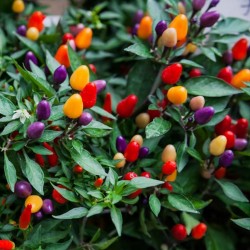Menu
-
Menuالعدمة
- Home
-
التصنيفات
-
-
التصنيفات
-
بذور الخضروات
-
أصناف حسب البلد
- أصناف من أرمينيا
- أصناف من البوسنة والهرسك
- أصناف من كرواتيا
- أصناف من فرنسا
- أصناف من ألمانيا
- أصناف من اليونان
- أصناف من المجر
- أصناف من الهند
- أصناف من إيطاليا
- أصناف من اليابان
- أصناف من شمال مقدونيا
- أصناف من بيرو
- أصناف من روسيا
- أصناف من صربيا
- أصناف من سلوفينيا
- أصناف من اسبانيا
- أصناف من تايلاند
- أصناف من تركيا
- أصناف من الولايات المتحدة الأمريكية
- بذور الطماطم
- بذور الذرة
- عائلة القرع
- الفول الأسرة
- بذور الخيار
- بذور الفلفل
- عائلة الجزرة
- عائلة البصل
- بذور الخس
- عائلة البطاطس
- عائلة الملفوف
- بذور الفجل
- عائلة الشمندر
- بذور البطيخ
- بذور بطيخ
- بذور القرنبيط
- عائلة عباد الشمس
-
أصناف حسب البلد
- بذور الفاكهة
- بذور الفلفل الحار
- بذور عشبة طبية
- تسلق بذور النباتات
- الأشجار - بذور بونساي
- بذور النخيل
- بذور الأعشاب الزينة
- بذور التبغ
-
بذور الخضروات
-
-
-
-
- منتجات جديدة
- التسليم - الدفع
- انشئ حساب
- FAQ
- الصفحة الرئيسية
-
- حزم كبيرة من البذور
- بذور النباتات العملاقة
- بذور الخضروات
- أصناف حسب البلد
- أصناف من أرمينيا
- أصناف من البوسنة والهرسك
- أصناف من كرواتيا
- أصناف من فرنسا
- أصناف من ألمانيا
- أصناف من اليونان
- أصناف من المجر
- أصناف من الهند
- أصناف من إيطاليا
- أصناف من اليابان
- أصناف من شمال مقدونيا
- أصناف من بيرو
- أصناف من روسيا
- أصناف من صربيا
- أصناف من سلوفينيا
- أصناف من اسبانيا
- أصناف من تايلاند
- أصناف من تركيا
- أصناف من الولايات المتحدة الأمريكية
- بذور الطماطم
- بذور الذرة
- عائلة القرع
- الفول الأسرة
- بذور الخيار
- بذور الفلفل
- عائلة الجزرة
- عائلة البصل
- بذور الخس
- عائلة البطاطس
- عائلة الملفوف
- بذور الفجل
- عائلة الشمندر
- بذور البطيخ
- بذور بطيخ
- بذور القرنبيط
- عائلة عباد الشمس
- أصناف حسب البلد
- بذور الفاكهة
- بذور الفلفل الحار
- بذور عشبة طبية
- تسلق بذور النباتات
- الأشجار - بذور بونساي
- بذور الموز
- بذور النخيل
- بذور الأعشاب الزينة
- بذور التبغ
- بذور زهرة
- بذور الصبار
- بذور النباتات المائية
- تعليمات البذر
- قوالب الفاكهة والخضروات
- فطر الفطر
- المصابيح النباتية
- بذور الخيزران
- نباتات الأيورفيدا
- F1 hybrid seeds
- التعبئة والتغليف والاشياء
- نباتات مقاومة للبرد
- منتجات العناية النباتية
- التوابل العضوية
- التسليم - الدفع
- لا دفع باي بال وبطاقة X
Last Product Reviews
Out of the two seeds, one germinated and the other one was dead and floatin...
By
 Riikka H on 07/03/2024
Riikka H on 07/03/2024
Verified Purchase
الأكثر مبيعاً
يوجد 1294 منتجا.
عرض 1276-1290 من 1294 منتجات
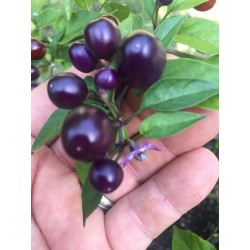
Chili 'Filius Blue' Seeds
السعر
8.50 €
(SKU: C 32)
Seeds Gallery EU,
5/
5
<h2><span style="text-decoration:underline;"><em><strong>Chili 'Filius Blue' Seeds</strong></em></span></h2>
<h3><span style="color:#ff0000;"><strong>Price for Package of 10 or 50 seeds.<br /></strong></span></h3>
<div>The Filius Blue is a beautiful ornamental and edible pepper. The Filius Blue has beautiful dark purple leaves. The peppers, which are growing upright, color from purple-blue to orange, yellow and end up red end when the pepper is ripe. This takes about 80 days after transplanting. De purple-blue pepper has more heat than the ripe red pepper. The plant will grow about 50 to 60 cm tall. The plant may be grown in vase. </div>
<div>
<table><tbody><tr><td><span style="color:#008000;">Official name:</span></td>
<td><span style="color:#008000;">Filius Blue</span></td>
</tr><tr><td><span style="color:#008000;">Species:</span></td>
<td><span style="color:#008000;">Annuum</span></td>
</tr><tr><td><span style="color:#008000;">Flower color:</span></td>
<td><span style="color:#008000;">White with purple</span></td>
</tr><tr><td><span style="color:#008000;">Fruit discoloration:</span></td>
<td><span style="color:#008000;">Dark purple</span><br /><span style="color:#008000;">Light purple</span><br /><span style="color:#008000;">Yellow orange</span><br /><span style="color:#008000;">Deep orange</span><br /><span style="color:#008000;">Bright red</span></td>
</tr><tr><td><span style="color:#008000;">Yield:</span></td>
<td><span style="color:#008000;">Very high</span></td>
</tr><tr><td><span style="color:#008000;">Harvest time min:</span></td>
<td><span style="color:#008000;">80</span></td>
</tr><tr><td><span style="color:#008000;">Plant height min:</span></td>
<td><span style="color:#008000;">50</span></td>
</tr></tbody></table></div>
C 32

- على الإنترنت فقط!

نبات مقاوم للبرد والصقيع

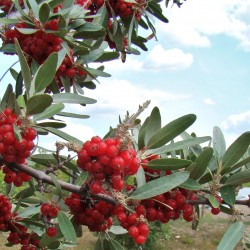
Russet Buffaloberry Seeds...
السعر
1.95 €
(SKU: V 64)
Seeds Gallery EU,
5/
5
<h2><strong>Russet Buffaloberry Seeds (Shepherdia canadensis)</strong></h2>
<h2><span style="color: #ff0000;"><strong>Price for Package of 5 seeds.</strong></span></h2>
<div>Hardy, Adaptable, Easy to Grow, Fast Growth, Edible Fruits, Attracts Birds, Wildlife Food/Shelter, Cold, Heat, Drought, Salt and Wind Tolerant, Nitrogen Fixing.</div>
<div> Shepherdia canadensis, also known as Russet Buffaloberry, Soopolallie, Soapberry, or Foamberry, is one of a small number of shrubs of the genus Shepherdia bearing edible red berries. The berries have an extremely bitter taste. The plant is a deciduous shrub found in open forests and thickets all over North America. Its northern limit is around the Arctic Circle. The shrub reaches a height of 3 to 13 feet. Fruits are extensively collected by some Canadian First Nations peoples such as Nlaka'pamux (Thompson), St̓átimc and Secwepemc (Shuswap) in the province of British Columbia. The bitter berries are not eaten directly but rather processed as sxusem ("sxushem") or "Indian ice-cream". Branches bearing fruit are hit with a stick and only the very ripe fruits that fall off are collected. A clean mat or tarpaulin is placed below the bush for collection. The berries are later placed into a great bowl that is absolutely free of oil or fat and are mixed with some sweet fruit such as raspberries. The mixture of berries is crushed and vigorously beaten in the manner of whipping cream in order to raise the typical foam of the sxusem confection. Sxusem has an agreeable blend of sweet and somewhat bitter tastes, possibly comparable to that encountered in sweetened coffee. The substance is believed by the First Nations peoples who prepare it to have many healthful properties, but the saponin chemicals making up the foam may also cause gastrointestinal irritation if consumed greatly. Native theme restaurants in British Columbia have occasionally had sxusem on the menu in recent years.</div>
<div>Leaf: Alternate, simple, elliptical to ovate, entire margins, 1 to 2 inches long, somewhat thickened dark green above with numerous silvery white scales, silvery white below with red-brown scales. </div>
<div>Flower: Dioecious; male and female flowers both light yellow-green, small (1/6 inch) and inconspicuous, appearing in early spring. </div>
<div>Fruit: A bright red drupe-like achene, 1/3 inch long and somewhat elongated, generally with a few silvery scales, ripen in mid to late summer and often occur in great abundance. </div>
<div>Twig: Slender, light brown and covered in numerous reddish brown, scruffy scales; buds stalked with valvate scales, flower buds more round. </div>
<div>Bark: Shiny reddish gray with numerous lenticels that develop into larger cracks and splits. </div>
<div>Form: A small shrub reaching up to 6 feet in height (occasionally much larger) with a dense rounded crown.</div>
<div>Other Names: Russet Buffaloberry, Russet Buffalo berry, Hippophae canadensis, Rabbitberry, Foamberry Soapberry, Soopalollie, Canadian Buffaloberry</div>
<div>Zone: 2 to 6</div>
<div>Growth Rate: Fast</div>
<div>Plant Type: Deciduous Shrub</div>
<div>Family: Elaeagnaceae</div>
<div>Height: 6 to 8 feet</div>
<div>Spread: 6 to 8 feet</div>
<div>Shape: Upright, rounded</div>
<div>Bloom Time: April-May</div>
<div>Bloom Color: Yellow</div>
<div>Flower/Fruit: Small, inconspicuous, yellow flowers are followed by yellowish-red, oval-shaped fruits.</div>
<div>Sun: Sun-Part Shade</div>
<div>Drought Tolerance: High</div>
<div>Water: Medium</div>
<div>Maintenance: Medium</div>
<div>Site Requirements/ Soil Tolerances: Easily grown in average, medium, well-drained soil in full sun to part shade. Tolerates wide range of soils. Very hardy and adaptable. Give it plenty of room to spread.</div>
<div>Culture: Can be pruned to a small tree. Remove root suckers and runners to control any unwanted spread of the plant. To keep it at a low height, cut it back to knee high every 5 to 10 years. If it gets too leggy, it can be cut back to the ground and it will come back bushier and with more berries the next year.</div>
<div>Uses: Wildlife shelter, screens, windbreaks. Naturalize in open woodland areas where it can be allowed to spread. Erosion control on slopes. Native plant gardens. Informal hedge. Good for dry, salty, high-pH soils, such as along highways.</div>
<div>
<table cellspacing="0" cellpadding="0" border="1">
<tbody>
<tr>
<td colspan="2" width="100%" valign="top">
<p><span style="color: #008000;"><strong>Sowing Instructions</strong></span></p>
</td>
</tr>
<tr>
<td valign="top" nowrap="nowrap">
<p><span style="color: #008000;"><strong>Propagation:</strong></span></p>
</td>
<td valign="top">
<p><span style="color: #008000;">Seeds</span></p>
</td>
</tr>
<tr>
<td valign="top" nowrap="nowrap">
<p><span style="color: #008000;"><strong>Pretreat:</strong></span></p>
</td>
<td valign="top">
<p><span style="color: #008000;">Pour Hot water over seed. Soak in water for 24 hours</span></p>
</td>
</tr>
<tr>
<td valign="top" nowrap="nowrap">
<p><span style="color: #008000;"><strong>Stratification:</strong></span></p>
</td>
<td valign="top">
<p><span style="color: #008000;">3 months in moist sowing mix at 2-5 ° C refrigerator</span></p>
</td>
</tr>
<tr>
<td valign="top" nowrap="nowrap">
<p><span style="color: #008000;"><strong>Sowing Time:</strong></span></p>
</td>
<td valign="top">
<p><span style="color: #008000;">all year round</span></p>
</td>
</tr>
<tr>
<td valign="top" nowrap="nowrap">
<p><span style="color: #008000;"><strong>Sowing Depth:</strong></span></p>
</td>
<td valign="top">
<p><span style="color: #008000;">1 cm</span></p>
</td>
</tr>
<tr>
<td valign="top" nowrap="nowrap">
<p><span style="color: #008000;"><strong>Sowing Mix:</strong></span></p>
</td>
<td valign="top">
<p><span style="color: #008000;">Coir or sowing mix + sand or perlite</span></p>
</td>
</tr>
<tr>
<td valign="top" nowrap="nowrap">
<p><span style="color: #008000;"><strong>Germination temperature:</strong></span></p>
</td>
<td valign="top">
<p><span style="color: #008000;">min. 20 ° C</span></p>
</td>
</tr>
<tr>
<td valign="top" nowrap="nowrap">
<p><span style="color: #008000;"><strong>Location:</strong></span></p>
</td>
<td valign="top">
<p><span style="color: #008000;">bright + keep constantly moist not wet</span></p>
</td>
</tr>
<tr>
<td valign="top" nowrap="nowrap">
<p><span style="color: #008000;"><strong>Germination Time:</strong></span></p>
</td>
<td valign="top">
<p><span style="color: #008000;">until it germinates </span></p>
</td>
</tr>
<tr>
<td valign="top" nowrap="nowrap">
<p><span style="color: #008000;"><strong>Watering:</strong></span></p>
</td>
<td valign="top">
<p><span style="color: #008000;">Water regularly during the growing season</span></p>
</td>
</tr>
<tr>
<td valign="top" nowrap="nowrap">
<p><span style="color: #008000;"><strong> </strong></span></p>
</td>
<td valign="top">
<p><br /><span style="color: #008000;"><em>Copyright © 2012 Seeds Gallery - Saatgut Galerie - Galerija semena. </em><em>All Rights Reserved.</em><em></em></span></p>
</td>
</tr>
</tbody>
</table>
</div>
V 64 (5 S)

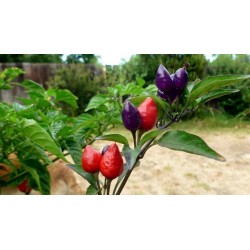
Chili Numex Centennial Seeds
السعر
1.50 €
(SKU: C 38)
Seeds Gallery EU,
5/
5
<h2><span style="text-decoration:underline;"><em><strong><span style="line-height:1.5em;">Chili Numex Centennial Seeds</span></strong></em></span></h2>
<h3><strong><span style="line-height:1.5em;color:#ff0000;">Price for Package of 5 seeds.</span></strong><span style="font-size:10pt;"><strong><span style="line-height:1.5em;color:#ff0000;"><br /></span></strong></span></h3>
<div><span style="font-size:10pt;line-height:1.5em;">This was the first ornamental variety released from NMSU intended for growing in small containers. It was released in 1988 to celebrate NMSU's Centennial celebrations. Many seed companies offer seed of this cultivar, unfortunately, under different names. 'NuMex Centennial' has purple flowers and purple foliage. The upright fruits are purple, then ripen to yellow, orange, and finally red. Very similar in appearence to the Bolivian Rainbow.</span></div>
<div><span style="font-size:10pt;line-height:1.5em;">Species: Annuum</span></div>
<div>Origin: New Mexico</div>
C 38


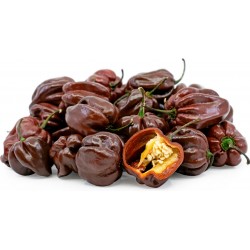
Habanero Chocolate Seeds
السعر
2.00 €
(SKU: C 19 C)
Seeds Gallery EU,
5/
5
<h2><strong>Habanero Chocolate Seeds</strong></h2>
<h2><strong style="color:#ff0000;">Price for Package of 5 seeds.</strong></h2>
<p><strong style="color:#ff0000;"></strong>The habanero is a variety of chili pepper. When used in English, it is sometimes spelled (and pronounced) habañero—the diacritical mark being added as a hyperforeignism. Unripe habaneros are green, and they color as they mature. Common colors are orange and red, but white, brown, and pink are also seen. Typically a ripe habanero chili is 2–6 centimetres (0.8–2.4 in) long. Habanero chilis are intensely hot, rated 100,000–350,000 on the Scoville scale.</p>
<p>The habanero chili comes from the Amazonas region, and from there it was spread in Mexico. One domesticated habanero, which was dated at 8,500 years old, was found at an archaeological dig in Mexico. [4] An intact fruit of a small domesticated habanero was found in Pre-ceramic levels in Guitarrero Cave in the Peruvian highlands, and was dated to 6500 B.C.E. It migrated north to the Caribbean via Colombia.</p>
<p>Upon its discovery by Spaniards, it was rapidly disseminated to other adequate climate areas of the world, to the point that 18th-century taxonomists mistook China for its place of origin and called it "Capsicum chinense"—the Chinese pepper.</p>
<p>Today, the largest producer is Mexico's Yucatan Peninsula.[8] Other modern producers include Belize, Panama (locally named ají chombo), Costa Rica, Colombia, Ecuador and parts of the United States, including Texas, Idaho, and California. While Mexico is the largest consumer of this spicy ingredient, its flavor and aroma have become increasingly popular all over the world.</p>
<p>Habaneros are an integral part of Yucatecan food. Habanero chilies accompany most dishes in Yucatán, either in solid or purée/salsa form.</p>
<p>The Scotch bonnet is often compared to the habanero, since they are two varieties of the same species, but have different pod types. Both the Scotch bonnet and the habanero have the characteristic thin, waxy flesh. They have a similar heat level and flavor. Although both varieties average around the same level of "heat", the actual degree of piquancy varies greatly from one fruit to another with genetics, growing methods, climate, and plant stress.</p>
<p>The habanero's heat, its fruity, citrus-like flavor, and its floral aroma have made it a popular ingredient in hot sauces and spicy foods. Habaneros are sometimes placed in tequila or mezcal bottles, particularly in Mexico, for a period ranging from several days to several weeks, to make a spiced version of the drink.</p>
<p>In 2000, the habanero was listed in the Guinness book of World Records as the world's hottest chili, but it has since been displaced by a number of other peppers, the record tending to change hands every few years.</p>
<p>Today, the largest producer is Mexico's Yucatan Peninsula. Other modern producers include Belize, Panama (locally named ají chombo), Costa Rica, Colombia, Ecuador and parts of the United States, including Texas, Idaho, and California. While Mexico is the largest consumer of this spicy ingredient, its flavor and aroma have become increasingly popular all over the world.</p>
<p>Habaneros are an integral part of Yucatecan food. Habanero chilies accompany most dishes in Yucatán, either in solid or purée/salsa form.</p>
<p>The Scotch bonnet is often compared to the habanero, since they are two varieties of the same species, but have different pod types. Both the Scotch bonnet and the habanero have the characteristic thin, waxy flesh. They have a similar heat level and flavor. Although both varieties average around the same level of "heat", the actual degree of piquancy varies greatly from one fruit to another with genetics, growing methods, climate, and plant stress.</p>
<p>The habanero's heat, its fruity, citrus-like flavor, and its floral aroma have made it a popular ingredient in hot sauces and spicy foods. Habaneros are sometimes placed in tequila or mezcal bottles, particularly in Mexico, for a period ranging from several days to several weeks, to make a spiced version of the drink.</p>
<p>In 2000, the habanero was listed in the Guinness book of World Records as the world's hottest chili, but it has since been displaced by a number of other peppers, the record tending to change hands every few years.</p>
<p>Habaneros thrive in hot weather. As with all peppers, the habanero does well in an area with good morning sun and in soil with a pH level around 5 to 6 (slightly acidic). The habanero should be watered only when dry. Overly moist soil and roots will produce bitter-tasting peppers.The habanero is a perennial flowering plant, meaning that with proper care and growing conditions, it can produce flowers (and thus fruit) for many years. Habanero bushes are good candidates for a container garden. In temperate climates, though, it is treated as an annual, dying each winter and being replaced the next spring. In tropical and subtropical regions, the habanero, like other chiles, will produce year round. As long as conditions are favorable, the plant will set fruit continuously.</p>
<p>Several growers have attempted to selectively breed habanero plants to produce hotter, heavier, and larger peppers. Most habaneros rate between 200,000 and 300,000 Scoville units.</p>
<p>In 2004, researchers in Texas created a mild version of the habanero, but retained the aroma and flavor of the traditional pepper. The milder version was obtained by crossing the Yucatán habanero pepper with a heatless habanero from Bolivia over several generations. These mild habaneros were expected to be widely available in the future as of 2004.</p>
<p>Black habanero is an alternative name often used to describe the dark brown variety of habanero chilis (although they're slightly different, being slightly smaller and slightly more sphere-shaped). There have been cases where some types of seeds have been found, and they're thought to be over 7,000 years old. It (the black habanero) has an exotic and unusual taste and is hotter than a regular habanero with a Scoville rating that ranges between 400,000 and 450,000 Scoville units. Small slivers used in cooking can have a dramatic effect on the overall dish. Gourmets delight in its fiery heat and unusual flavor. Black habaneros take considerably longer to grow than other habanero chili varieties. In a dried form, they can be preserved for long periods of time, and can be reconstituted in water then added to sauce mixes. Previously known as habanero negro, or by their Nahuatl name, they were translated into English by spice traders in the 19th century as "black habanero". The word "chocolate" was derived from the Nahuatl word, xocolātl [ʃo'kolaːt͡ɬ], and was used in the description as well (as "chocolate habanero"), but it proved to be unpronounceable to the British traders, so it was simply named "black habanero".</p>
C 19 C

- على الإنترنت فقط!

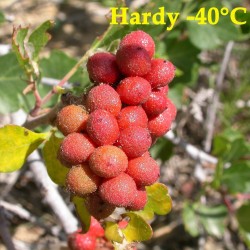
Skunkbush Sumac Seeds (rhus...
السعر
2.90 €
(SKU: V 49)
Seeds Gallery EU,
5/
5
<h2><strong>Skunkbush Sumac Seeds (rhus trilobata) </strong><strong>Exotic Fruit<br /></strong></h2>
<h2><span style="color: #ff0000;"><strong>Price for Package of 5 seeds.</strong></span></h2>
<p>A low deciduous shrub that offers attractive flowers in spring and bright fruits and foliage in fall, skunkbush sumac is native to western North America. In mid-spring before the leaves emerge, conspicuous clusters of pale yellow flowers appear at the stem tips. Small berries follow, ripening red in late summer. Resembling poison ivy foliage, the downy three-lobed leaves are mildly glossy and medium to dark green. The leaflets have blunt-toothed edges. Bruised leaves release a malodorous scent. In autumn, the foliage turns fiery colors. </p>
<p>Skunkbush sumac does best in full sun and moderately moist soil, with the brightest autumn color produced under such conditions. In drier soil plants are smaller. Use this extremely hardy shrub as a loose low screen at the edge of a woodland or building, or to clothe a bank or other erosion-prone site. Plants may sucker and form a thicket in some conditions.</p>
<p>Genus: Rhus </p>
<p>Species: trilobata</p>
<p>Common Name: Skunkbush Sumac</p>
<p>Other Name: Schamltzia trilobata, Rhus Canadensis var. Trilobata, Quailbush</p>
<p>Pre-treatment: required</p>
<p>Zone Hardiness Cold: 4</p>
<p>Zone Hardiness warm: 7</p>
<p>Plant Type: Small Shrub</p>
<p>Height / Width: 1-2m/2-3m</p>
<p>Growth rate: medium</p>
<p>Vegetation type: decidious</p>
<p>Leaf /Flower color: green/yellow-green</p>
<p>Light</p>
<p>Conditions : Light Conditions </p>
<p>Unless a site is completely exposed, light conditions will change during the day and even during the year. The northern and eastern sides of a house receive the least amount of light, with the northern exsposure being the shadiest. The western and southern sides of a house receive the most light and are conidered the hottest exposures due to intense afternoon sun.</p>
<p>You will notice that sun and shade patterns change during the day. The western side of a house may even be shady due to shadows cast by large trees or a structure from an adjacent property. If you have just bought a new home or just beginning to garden in your older home, take time to map sun and shade throughout the day. You will get a more accurate feel for your site's true light conditions.</p>
<p>Conditions : Full to Partial Sun </p>
<p>Full sunlight is needed for many plants to assume their full potential. Many of these plants will do fine with a little less sunlight, although they may not flower as heavily or their foliage as vibrant. Areas on the southern and western sides of buildings usually are the sunniest. The only exception is when houses or buildings are so close together, shadows are cast from neighboring properties. Full sun usually means 6 or more hours of direct unobstructed sunlight on a sunny day. Partial sun receives less than 6 hours of sun, but more than 3 hours. Plants able to take full sun in some climates may only be able to tolerate part sun in other climates. Know the culture of the plant before you buy and plant it!</p>
<p>Watering</p>
<p>Conditions : Moist and Well Drained </p>
<p>Moist and well drained means exactly what it sounds like. Soil is moist without being soggy because the texture of the soil allows excess moisture to drain away. Most plants like about 1 inch of water per week. Amending your soil with compost will help improve texture and water holding or draining capacity. A 3 inch layer of mulch will help to maintain soil moisture and studies have shown that mulched plants grow faster than non-mulched plants.</p>
<p>Planting</p>
<p>How-to : Planting Shrubs </p>
<p>Dig a hole twice the size of the root ball and deep enough to plant at the same level the shrub was in the container. If soil is poor, dig hole even wider and fill with a mixture half original soil and half compost or soil amendment.</p>
<p>Carefully remove shrub from container and gently separate roots. Position in center of hole, best side facing forward. Fill in with original soil or an amended mixture if needed as described above. For larger shrubs, build a water well. Finish by mulching and watering well.</p>
<p>If the plant is balled-and-burlapped, remove fasteners and fold back the top of natural burlap, tucking it down into hole, after you've positioned shrub. Make sure that all burlap is buried so that it won't wick water away from rootball during hot, dry periods. If synthetic burlap, remove if possible. If not possible, cut away or make slits to allow for roots to develop into the new soil. For larger shrubs, build a water well. Finish by mulching and watering well.</p>
<p>If shrub is bare-root, look for a discoloration somewhere near the base; this mark is likely where the soil line was. If soil is too sandy or too clayey, add organic matter. This will help with both drainage and water holding capacity. Fill soil, firming just enough to support shrub. Finish by mulching and watering well.</p>
<p>Problems</p>
<p>Diseases : Verticillium or Fusarium Wilt </p>
<p>Wilts may be contracted through infected seed, plant debris, or soil. This fungus begins and multiplies during the cool, moist season, becoming obvious when weather turns warm and dry. Plants wilt because the fungus damages their water conducting mechanisms. Overfertilization can worsen this problem. Able to overwinter in soil for many years, it is also carried and harbored in common weeds.</p>
<p>Prevention and Control: If possible, select resistant varieties. Keep nitrogen-heavy fertilizers to a minimum as well as over-irrigating as they encourage lush growth. Practice crop rotation and prune out or better yet remove infected plants.</p>
<p>Fungi : Powdery Mildew </p>
<p>Powdery Mildew is usually found on plants that do not have enough air circulation or adequate light. Problems are worse where nights are cool and days are warm and humid. The powdery white or gray fungus is usually found on the upper surface of leaves or fruit. Leaves will often turn yellow or brown, curl up, and drop off. New foliage emerges crinkled and distorted. Fruit will be dwarfed and often drops early.</p>
<p>Prevention and Control: Plant resistant varieties and space plants properly so they receive adequate light and air circulation. Always water from below, keeping water off the foliage. This is paramount for roses. Go easy on the nitrogen fertilizer. Apply fungicides according to label directions before problem becomes severe and follow directions exactly, not missing any required treatments. Sanitation is a must - clean up and remove all leaves, flowers, or debris in the fall and destroy.</p>
<p>Pest : Caterpillars </p>
<p>Caterpillars are the immature form of moths and butterflies. They are voracious feeders attacking a wide variety of plants. They can be highly destructive and are characterized as leaf feeders, stem borers, leaf rollers, cutworms and tent-formers.</p>
<p>Prevention and Control: keep weeds down, scout individual plants and remove caterpillars, apply labeled insecticides such as soaps and oils, take advantage of natural enemies such as parasitic wasps in the garden and use Bacillus thuringiensis (biological warfare) for some caterpillar species.</p>
<p>Fungi : Leaf Spots </p>
<p>Leaf spots are caused by fungi or bacteria. Brown or black spots and patches may be either ragged or circular, with a water soaked or yellow-edged appearance. Insects, rain, dirty garden tools, or even people can help its spread.</p>
<p>Prevention and Control: Remove infected leaves when the plant is dry. Leaves that collect around the base of the plant should be raked up and disposed of. Avoid overhead irrigation if possible; water should be directed at soil level. For fungal leaf spots, use a recommended fungicide according to label directions.</p>
<p>Pest : Scale Insects </p>
<p>Scales are insects, related to mealybugs, that can be a problem on a wide variety of plants - indoor and outdoor. Young scales crawl until they find a good feeding site. The adult females then lose their legs and remain on a spot protected by its hard shell layer. They appear as bumps, often on the lower sides of leaves. They have piercing mouth parts that suck the sap out of plant tissue. Scales can weaken a plant leading to yellow foliage and leaf drop. They also produce a sweet substance called honeydew (coveted by ants) which can lead to an unattractive black surface fungal growth called sooty mold.</p>
<p>Prevention and Control: Once established they are hard to control. Isolate infested plants away from those that are not infested. Cosnult your local garden center professional or Cooperative Extension office in your county for a legal recommendation regarding their control. Encourage natural enemies such as parasitic wasps in the garden.</p>
<p>Miscellaneous</p>
<p>Conditions : Deer Tolerant </p>
<p>There are no plants that are 100% deer resistant, but many that are deer tolerant. There are plants that deer prefer over others. You will find that what deer will or will not eat varies in different parts of the country. A lot of it has to do with how hungry they are. Most deer will sample everything at least once, decide if they like it or not and return if favorable. A fence is the good deer barrier. You may go for a really tall one (7 to 8 feet), or try 2 parallel fences, (4 to 5 feet apart). Use a wire mesh fence rather than board, since deer are capable of wiggling through a 12 inch space.</p>
<p>Conditions : Pollution Tolerant </p>
<p>Air pollution is becoming a bigger problem each day. Pollutants in our air damage plants. The plants are damaged by absorbing sulfur dioxide, ozone, peroxyacetyl nitrate, ethylene, and nitrogen dioxide through their pores. Cell membrane damage may result in leaf drop, blotched or burnt looking leaves, or off-colored tissue between veins. Vehicles and industrial processes are the key culprits and conditions worsen on hot summer days. Though planting only pollution tolerant plants is not the solution to this problem, it is a visual bandaid. Your Cooperative Extension Service may have a list of plants that are more pollution tolerant in your area. </p>
<p>Conditions : Rabbit Tolerant </p>
<p>As cute as they are, rabbits can really damage a vegetable garden. Young, tender lettuce plants seem to be their favorite. If a free-roaming dog is not a possiblility for you, consider installing raised vegetable beds and covering tender shoots with netting. If you have ample room, you can opt to plant enough for you and the bunnies. Scents don't always repel animals, as they get used to them and are often washed off in the rain. </p>
<p>Conditions : Slope Tolerant </p>
<p>Slope tolerant plants are those that have a fibrous root system and are often plants that prefer good soil drainage. These plants assist in erosion control by stabilizing/holding the soil on slopes intact. </p>
<p>Conditions : Wind Tolerant </p>
<p>Plants that are wind tolerant usually have flexible, strong branches that are not brittle. Wind tolerant plants often have thick or waxy leaves that control moisture loss from whipping winds. Native plants are often the best adapted to not only wind, but also soil and other climatic conditions. </p>
<p>Conditions : Fall Color </p>
<p>Fall color is the result of trees or shrubs changing colors according to complex chemical formulas present in their leaves. Depending on how much iron, magnesium, phosphorus, or sodium is in the plant, and the acidity of the chemicals in the leaves, leaves might turn amber, gold, red, orange or just fade from green to brown. Scarlet oaks, red maples and sumacs, for instance, have a slightly acidic sap, which causes the leaves to turn bright red. The leaves of some varieties of ash, growing in areas where limestone is present, will turn a regal purplish-blue.</p>
<p>Although many people believe that cooler temperatures are responsible for the color change, the weather has nothing to do with it at all. As the days grow shorter and the nights longer, a chemical clock inside the trees starts up, releasing a hormone which restricts the flow of sap to each leaf. As fall progresses, the sap flow slows and chlorophyll, the chemical that gives the leaves their green color in the spring and summer, disappears. The residual sap becomes more concentrated as it dries, creating the colors of fall. </p>
<p>Glossary : Deciduous </p>
<p>Deciduous refers to those plants that lose their leaves or needles at the end of the growing season.</p>
<p>Glossary : Shrub </p>
<p>Shrub: is a deciduous or evergreen woody perennial that has multiple branches that form near its base. </p>
<p>Glossary : Heat Zone </p>
<p>The 12 zones of the AHS Heat Zone map indicate the average number of days each year that a given region experiences ""heat days"" or temperatures over 86 degrees F(30 degrees Celsius). That is the point at which plants begin suffering physiological damage from heat. The zones range from Zone 1 (less than one heat day) to Zone 12 (more than 210 heat days). The AHS Heat Zone, which deals with heat tolerance, should not be confused with the USDA Hardiness Zone system which deals with cold tolerance. For example: Seattle, Washington has a USDA Hardiness Zone of 8, the same as Charleston, South Carolina; however Seattle's Heat Zone is 2 where Charleston's Heat Zone is 11. What this says is that winter temperature in the two cities may be similar, but because Charleston has significantly warmer weather for a longer period of time, plant selection based on heat tolerance is a factor to consider. </p>
<p>Glossary : Plant Characteristics </p>
<p>Plant characteristics define the plant, enabling a search that finds specific types of plants such as bulbs, trees, shrubs, grass, perennials, etc. </p>
<p>Glossary : Medium Shrub </p>
<p>A medium shrub is generally between 3 and 6 feet tall. </p>
<p>Glossary : Flower Characteristics </p>
<p>Flower characteristics can vary greatly and may help you decide on a ""look or feel"" for your garden. If you're looking for fragrance or large, showy flowers, click these boxes and possibilities that fit your cultural conditions will be shown. If you have no preference, leave boxes unchecked to return a greater number of possibilities. </p>
<p>Glossary : Foliage Characteristics </p>
<p>By searching foliage characteristics, you will have the opportunity to look for foliage with distinguishable features such as variegated leaves, aromatic foliage, or unusual texture, color or shape. This field will be most helpful to you if you are looking for accent plants. If you have no preference, leave this field blank to return a larger selection of plants. </p>
<div> </div>
<table border="1" cellspacing="0" cellpadding="0">
<tbody>
<tr>
<td colspan="2" valign="top" width="100%">
<p><span style="color: #008000;"><strong>Sowing Instructions</strong></span></p>
</td>
</tr>
<tr>
<td valign="top" nowrap="nowrap">
<p><span style="color: #008000;"><strong>Propagation:</strong></span></p>
</td>
<td valign="top">
<p><span style="color: #008000;">Seeds</span></p>
</td>
</tr>
<tr>
<td valign="top" nowrap="nowrap">
<p><span style="color: #008000;"><strong>Pretreat:</strong></span></p>
</td>
<td valign="top">
<p><span style="color: #008000;">pour over with hot water + Soak about 24 hrs</span></p>
</td>
</tr>
<tr>
<td valign="top" nowrap="nowrap">
<p><span style="color: #008000;"><strong>Stratification:</strong></span></p>
</td>
<td valign="top">
<p><span style="color: #008000;">0</span></p>
</td>
</tr>
<tr>
<td valign="top" nowrap="nowrap">
<p><span style="color: #008000;"><strong>Sowing Time:</strong></span></p>
</td>
<td valign="top">
<p><span style="color: #008000;">all year round</span></p>
</td>
</tr>
<tr>
<td valign="top" nowrap="nowrap">
<p><span style="color: #008000;"><strong>Sowing Depth:</strong></span></p>
</td>
<td valign="top">
<p><span style="color: #008000;">Just lightly cover with substrate</span></p>
</td>
</tr>
<tr>
<td valign="top" nowrap="nowrap">
<p><span style="color: #008000;"><strong>Sowing Mix:</strong></span></p>
</td>
<td valign="top">
<p><span style="color: #008000;">Coir or sowing mix + sand or perlite</span></p>
</td>
</tr>
<tr>
<td valign="top" nowrap="nowrap">
<p><span style="color: #008000;"><strong>Germination temperature:</strong></span></p>
</td>
<td valign="top">
<p><span style="color: #008000;">min. 20 ° C</span></p>
</td>
</tr>
<tr>
<td valign="top" nowrap="nowrap">
<p><span style="color: #008000;"><strong>Location:</strong></span></p>
</td>
<td valign="top">
<p><span style="color: #008000;">bright + keep constantly moist not wet</span></p>
</td>
</tr>
<tr>
<td valign="top" nowrap="nowrap">
<p><span style="color: #008000;"><strong>Germination Time:</strong></span></p>
</td>
<td valign="top">
<p><span style="color: #008000;">until it germinates </span></p>
</td>
</tr>
<tr>
<td valign="top" nowrap="nowrap">
<p><span style="color: #008000;"><strong>Watering:</strong></span></p>
</td>
<td valign="top">
<p><span style="color: #008000;">Water regularly during the growing season</span></p>
</td>
</tr>
<tr>
<td valign="top" nowrap="nowrap">
<p><span style="color: #008000;"><strong> </strong></span></p>
</td>
<td valign="top">
<p><br /><span style="color: #008000;"><em>Copyright © 2012 Seeds Gallery - Saatgut Galerie - Galerija semena. </em><em>All Rights Reserved.</em><em></em></span></p>
<div><span style="color: #008000;"><em> </em></span></div>
</td>
</tr>
</tbody>
</table>
V 49 (5 S)

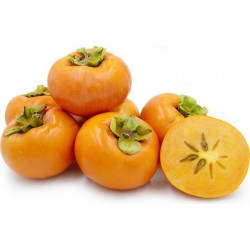
(Diospyros virginiana) بذور...
السعر
3.50 €
(SKU: V 25 A)
Seeds Gallery EU,
5/
5
<h2 class=""><strong>(Diospyros virginiana) بذور البرسيمون الأمريكية</strong></h2>
<h2><span style="color: #ff0000;"><strong>ثمن عبوة 5 بذور.</strong></span></h2>
<p>The American persimmon produces a large crop of sweet edible fruit with very little attention but also produces valuable timber and is great for bees and therefore for honey production. The persimmon is easy to grow with fast growth until fruiting commences.</p>
<div>
<div> It will grow to a height of about 15ft in the first 5 years. It prefers a deep, loamy, well-drained soil, but will tolerate any soil that is not waterlogged. The tree is drought resistant.</div>
<div>The American Indian used the fruit in gruel, cornbread and puddings and with honey locust pods, made an alcoholic beverage.</div>
<div>The American persimmon mixed with cornmeal can be brewed into "simmon beer". Vinegar could also be made with this fruit.</div>
<div> The fruit can provide a self feeding fodder crop for livestock. All livestock enjoy the ripe fruit as they fall from the tree. They are also popular with wildlife.</div>
<div>Good fruiting trees can be grown from the seeds. Fruiting begins, and continues for fifty years or more.</div>
<div> The tree is hardy to -29 C.</div>
<table cellspacing="0" cellpadding="0" border="1">
<tbody>
<tr>
<td colspan="2" width="100%" valign="top">
<p><span style="color: #008000;"><strong>Sowing Instructions</strong></span></p>
</td>
</tr>
<tr>
<td valign="top" nowrap="nowrap">
<p><span style="color: #008000;"><strong>Propagation:</strong></span></p>
</td>
<td valign="top">
<p><span style="color: #008000;">Seeds</span></p>
</td>
</tr>
<tr>
<td valign="top" nowrap="nowrap">
<p><span style="color: #008000;"><strong>Pretreat:</strong></span></p>
</td>
<td valign="top">
<p><span style="color: #008000;">soak in water for 24 hours </span></p>
</td>
</tr>
<tr>
<td valign="top" nowrap="nowrap">
<p><span style="color: #008000;"><strong>Stratification:</strong></span></p>
</td>
<td valign="top">
<p><span style="color: #008000;">3 months in moist sowing mix at 2-5 ° C refrigerator</span></p>
</td>
</tr>
<tr>
<td valign="top" nowrap="nowrap">
<p><span style="color: #008000;"><strong>Sowing Time:</strong></span></p>
</td>
<td valign="top">
<p><span style="color: #008000;">all year round</span></p>
</td>
</tr>
<tr>
<td valign="top" nowrap="nowrap">
<p><span style="color: #008000;"><strong>Sowing Depth:</strong></span></p>
</td>
<td valign="top">
<p><span style="color: #008000;">1 - 2,5 cm</span></p>
</td>
</tr>
<tr>
<td valign="top" nowrap="nowrap">
<p><span style="color: #008000;"><strong>Sowing Mix:</strong></span></p>
</td>
<td valign="top">
<p><span style="color: #008000;">Coir or sowing mix + sand or perlite</span></p>
</td>
</tr>
<tr>
<td valign="top" nowrap="nowrap">
<p><span style="color: #008000;"><strong>Germination temperature:</strong></span></p>
</td>
<td valign="top">
<p><span style="color: #008000;">20 ° C</span></p>
</td>
</tr>
<tr>
<td valign="top" nowrap="nowrap">
<p><span style="color: #008000;"><strong>Location:</strong></span></p>
</td>
<td valign="top">
<p><span style="color: #008000;">bright + keep constantly moist not wet</span></p>
</td>
</tr>
<tr>
<td valign="top" nowrap="nowrap">
<p><span style="color: #008000;"><strong>Germination Time:</strong></span></p>
</td>
<td valign="top">
<p><span style="color: #008000;">until it germinates </span></p>
</td>
</tr>
<tr>
<td valign="top" nowrap="nowrap">
<p><span style="color: #008000;"><strong>Watering:</strong></span></p>
</td>
<td valign="top">
<p><span style="color: #008000;">Water regularly during the growing season</span></p>
</td>
</tr>
<tr>
<td valign="top" nowrap="nowrap">
<p><span style="color: #008000;"><strong> </strong></span></p>
</td>
<td valign="top">
<p><br /><span style="color: #008000;"><em>Copyright © 2012 Seeds Gallery - Saatgut Galerie - Galerija semena. </em><em>All Rights Reserved.</em></span></p>
</td>
</tr>
</tbody>
</table>
</div>
V 25 A (2 S)


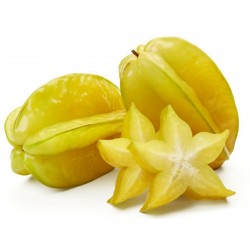
قلنباق بذور (Averrhoa...
السعر
4.00 €
(SKU: V 9 AC)
Seeds Gallery EU,
5/
5
<h2><strong>قلنباق بذور (Averrhoa carambola)</strong></h2>
<h2><span style="color: #ff0000;"><strong>ثمن عبوة 2 بذرة.</strong></span></h2>
<p>القُلُنْباق أو الرُشدِيّة أو كرمبولا ويسمى بمصر بُرتقال بَامِيَة (الاسم العلمي: Averrhoa carambola)، هو نبات ينتمي إلى الفصيلة الحماضية (باللاتينية: Oxalidaceae).</p>
<p>موطنه الأصلي جنوب شرق آسيا، ولكنه يزرع في مناطق أخرى مثل مصر.</p>
<p>This easy-to-grow fruiting tree will flower and fruit once it reaches a height of 1 1/2-2', often within the first year. Small clusters of lilac-colored flowers bloom intermittently year-rounbd followed by fruit, which ripens to a golden yellow usually within 3-4 months. Then the magic happens: slice the fruit in half and a beautiful 5-pointed star is discovered. As a bonus, the fruit from this mini tree is as sweet as that which comes from the larger trees. Grow in full sun in any well-drained potting mix with moderate amounts of fertilizer during the active growing season and 'Maher Dwarf' will produce fruit year after year. </p>
<div>
<table border="1" cellspacing="0" cellpadding="0">
<tbody>
<tr>
<td colspan="2" valign="top" width="100%">
<p><span style="color: #008000;"><strong>Sowing Instructions</strong></span></p>
</td>
</tr>
<tr>
<td valign="top" nowrap="nowrap">
<p><span style="color: #008000;"><strong>Propagation:</strong></span></p>
</td>
<td valign="top">
<p><span style="color: #008000;">Seeds </span></p>
</td>
</tr>
<tr>
<td valign="top" nowrap="nowrap">
<p><span style="color: #008000;"><strong>Pretreat:</strong></span></p>
</td>
<td valign="top">
<p><span style="color: #008000;">0</span></p>
</td>
</tr>
<tr>
<td valign="top" nowrap="nowrap">
<p><span style="color: #008000;"><strong>Stratification:</strong></span></p>
</td>
<td valign="top">
<p><span style="color: #008000;">0</span></p>
</td>
</tr>
<tr>
<td valign="top" nowrap="nowrap">
<p><span style="color: #008000;"><strong>Sowing Time:</strong></span></p>
</td>
<td valign="top">
<p><span style="color: #008000;">all year round</span></p>
</td>
</tr>
<tr>
<td valign="top" nowrap="nowrap">
<p><span style="color: #008000;"><strong>Sowing Depth:</strong></span></p>
</td>
<td valign="top">
<p><span style="color: #008000;">0.5 - 1 cm</span></p>
</td>
</tr>
<tr>
<td valign="top" nowrap="nowrap">
<p><span style="color: #008000;"><strong>Sowing Mix:</strong></span></p>
</td>
<td valign="top">
<p><span style="color: #008000;">Coir or sowing mix + sand or perlite</span></p>
</td>
</tr>
<tr>
<td valign="top" nowrap="nowrap">
<p><span style="color: #008000;"><strong>Germination temperature:</strong></span></p>
</td>
<td valign="top">
<p><span style="color: #008000;">about 22-25 ° C.</span></p>
</td>
</tr>
<tr>
<td valign="top" nowrap="nowrap">
<p><span style="color: #008000;"><strong>Location:</strong></span></p>
</td>
<td valign="top">
<p><span style="color: #008000;">bright + keep constantly moist not wet</span></p>
</td>
</tr>
<tr>
<td valign="top" nowrap="nowrap">
<p><span style="color: #008000;"><strong>Germination Time:</strong></span></p>
</td>
<td valign="top">
<p><span style="color: #008000;">3-6 weeks</span></p>
</td>
</tr>
<tr>
<td valign="top" nowrap="nowrap">
<p><span style="color: #008000;"><strong>Watering:</strong></span></p>
</td>
<td valign="top">
<p><span style="color: #008000;">Water regularly during the growing season</span></p>
</td>
</tr>
<tr>
<td valign="top" nowrap="nowrap">
<p><span style="color: #008000;"><strong> </strong></span></p>
</td>
<td valign="top">
<p><br><em><strong><span style="color: #008000;">Copyright © 2012 Seeds Gallery - Galerija semena. All Rights Reserved.</span></strong></em></p>
</td>
</tr>
</tbody>
</table>
</div><script src="//cdn.public.n1ed.com/G3OMDFLT/widgets.js"></script>
V 9 AC (2 S)

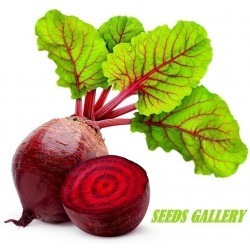
100 Seeds Egyptian Beetroot
السعر
1.15 €
(SKU: VE 230)
Seeds Gallery EU,
5/
5
<h2 class=""><strong>100 Seeds Egyptian Beetroot (Beta vulgaris)</strong></h2>
<h2 class=""><span style="color: #ff0000;"><strong>Price for Package of 100 seeds.</strong></span></h2>
<div>Heirloom variety dating back to 1800’s that produces a flattish beetroot with dark red flesh that has lighter zones. Excellent old fashioned flavour, eaten raw or cooked. Delicious edible tops</div>
<div>stay green and can be used as spinach or in salads. Early variety. 55 days.</div>
<script src="//cdn.public.n1ed.com/G3OMDFLT/widgets.js"></script>
VE 230 (1,5g)

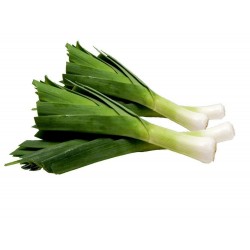
Kamus Leek Seeds – Allium...
السعر
1.75 €
(SKU: MHS 148)
Seeds Gallery EU,
5/
5
<h2><strong>Kamus Leek Seeds – Allium Porrum</strong></h2>
<div id="idTab1" class="rte">
<h2><span style="color: #ff0000;"><strong>Price for Package of 320 (1g) seeds.</strong></span></h2>
<div>Leek, which is in the same family as onions and garlic, has a similar taste to the other familiar vegetables in this family. Usually used as a fundamental ingredient in soups and broths; this tasty vegetable adds a wonderful oniony, earthy taste to any hearty meal.</div>
<div>
<p>This is a very resilient plant and can withstand winter weather easily until they are ready to be harvested.</p>
<p>From sowing these seeds, until full maturity, normally takes approximately 4 months, with germination taking 2-3 weeks.</p>
</div>
<table cellspacing="0" cellpadding="0" border="1">
<tbody>
<tr>
<td colspan="2" width="100%" valign="top">
<p><span style="color: #008000;"><strong>Sowing Instructions</strong></span></p>
</td>
</tr>
<tr>
<td valign="top" nowrap="nowrap">
<p><span style="color: #008000;"><strong>Propagation:</strong></span></p>
</td>
<td valign="top">
<p><span style="color: #008000;">Seeds</span></p>
</td>
</tr>
<tr>
<td valign="top" nowrap="nowrap">
<p><span style="color: #008000;"><strong>Pretreat:</strong></span></p>
</td>
<td valign="top">
<p><span style="color: #008000;">0</span></p>
</td>
</tr>
<tr>
<td valign="top" nowrap="nowrap">
<p><span style="color: #008000;"><strong>Stratification:</strong></span></p>
</td>
<td valign="top">
<p><span style="color: #008000;">0</span></p>
</td>
</tr>
<tr>
<td valign="top" nowrap="nowrap">
<p><span style="color: #008000;"><strong>Sowing Time:</strong></span></p>
</td>
<td valign="top">
<p><span style="color: #008000;">all year round </span></p>
</td>
</tr>
<tr>
<td valign="top" nowrap="nowrap">
<p><span style="color: #008000;"><strong>Sowing Depth:</strong></span></p>
</td>
<td valign="top">
<p><span style="color: #008000;">1 cm</span></p>
</td>
</tr>
<tr>
<td valign="top" nowrap="nowrap">
<p><span style="color: #008000;"><strong>Sowing Mix:</strong></span></p>
</td>
<td valign="top">
<p><span style="color: #008000;">Coir or sowing mix + sand or perlite</span></p>
</td>
</tr>
<tr>
<td valign="top" nowrap="nowrap">
<p><span style="color: #008000;"><strong>Germination temperature:</strong></span></p>
</td>
<td valign="top">
<p><span style="color: #008000;">+16 / +25°C</span></p>
</td>
</tr>
<tr>
<td valign="top" nowrap="nowrap">
<p><span style="color: #008000;"><strong>Location:</strong></span></p>
</td>
<td valign="top">
<p><span style="color: #008000;">bright + keep constantly moist not wet</span></p>
</td>
</tr>
<tr>
<td valign="top" nowrap="nowrap">
<p><span style="color: #008000;"><strong>Germination Time:</strong></span></p>
</td>
<td valign="top">
<p><span style="color: #008000;">2-3 weeks</span></p>
</td>
</tr>
<tr>
<td valign="top" nowrap="nowrap">
<p><span style="color: #008000;"><strong>Watering:</strong></span></p>
</td>
<td valign="top">
<p><span style="color: #008000;">Water regularly during the growing season</span></p>
</td>
</tr>
<tr>
<td valign="top" nowrap="nowrap">
<p><span style="color: #008000;"><strong> </strong></span></p>
</td>
<td valign="top">
<p><br><span style="color: #008000;"><em>Copyright © 2012 Seeds Gallery - Saatgut Galerie - Galerija semena. </em><em>All Rights Reserved.</em><em></em></span></p>
<div></div>
</td>
</tr>
</tbody>
</table>
</div>
<div id="idTab5" class="block_hidden_only_for_screen">
<p class="align_center">No customer comments for the moment.</p>
<p class="align_center">Only registered users can post a new comment.</p>
</div><script src="//cdn.public.n1ed.com/G3OMDFLT/widgets.js"></script>
MHS 148 (1g)

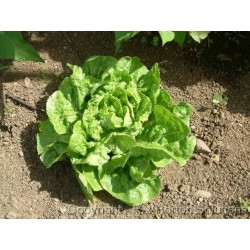
Lettuce Seeds 'Green...
السعر
1.50 €
(SKU: PL 1)
Seeds Gallery EU,
5/
5
<h2><strong>Lettuce Seeds 'Green Mignonette' Butterhead</strong></h2>
<h2 class=""><span style="color: #f80000;"><strong>Price for Package of 100 (0,09g) seeds.</strong></span></h2>
<div>Green Mignonette' is a butterhead lettuce type. It is an excellent home garden variety as it is easy to grow with exceptional eating qualities and is slow to bolt. It has soft, deep green, ruffled leaves, a loose heart and is very tender and sweet. It is suitable for planting for most of the year. Days to harvest: 25 days salad mix; 46 days full size.</div><script src="//cdn.public.n1ed.com/G3OMDFLT/widgets.js"></script>
PL 1 (100 S)

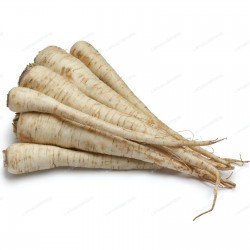
بذور بقدونس برلين (استخدام...
السعر
1.95 €
(SKU: VE 24 (1,4g))
Seeds Gallery EU,
5/
5
<h2 dir="rtl"><strong>بذور بقدونس برلين (استخدام مزدوج)</strong></h2>
<h2 dir="rtl"><span style="color: #ff0000;" class=""><strong>ثمن عبوة تحتوي على (1,4g) 1000+ بذرة.</strong></span></h2>
المَقْدُونِس وفي اللهجات العامية يُسمَّى : البقدونس أو المعدَنوس جنس :نباتي ينتمي إلى الفصيلة الخيمية. يضم هذا الجنس نوعا واحدا مقبولا هو المقدونس الهش (الشائع) وأنواع أخرى لم يحسم أمرها بعد<br><br>من أنواعه<br>المقدونس الهش (باللاتينية: Petroselinum crispum) في بلاد الشام والمغرب العربي<br>الوصف النباتي<br>نبات عشبي ثنائي الحول يتبع الفصيلة الخيمية. يتراوح ارتفاعه ما بين 6 إلى 20 سم، له سوق عديدة تنمو جميعها من جذر واحد والسوق قائمة ومدورة ومتفرعة. الأوراق مركبة. الأزهار في مجاميع مركبة ذات لون أبيض والنورات مركبة خيمية ويتميز المقدونس برائحته العطرية النفاذة وأوراقه الخضراء الزاهية. ومن أنواعه البلدي الأملس والأفرنجي المجعد. ويمكن الحصول على زيت المقدونس من البذور.<br><br>اسم البقدونس<br>هذا ما تقوله المعاجم المختلفة:<br><br>المعجم العربي الأساسي (المنظمة العربية للتربية والثقافة والعلوم - طبعة لاروس 1989)، وهو إجماع مجامع اللغة العربية المختلفة، يقول في ص. 1145:<br>مقدونس: نبات عشبي زراعي من فصيلة الخيميات يزرع لرائحة أوراقه ولأفاويه الطعام، ويقال له: مَعدَنُوس في تونس والجزائر والمغرب والعراق، وفي بعض الدول العربية يسمى (كرَفِس)<br><br>المعجم الوسيط (إصدار مجمع اللغة العربية في القاهرة) (ص. 915): مقدونس.<br>المصباح المنير ومختار الصحاح لا يحتويان على أي من النطقين.<br>ولكن أورده الفيروزأبادي في القاموس المحيط، فقال وهو يصف أحد النباتات :<br>(كالشَّبَث في ساقه وجُمَّته وأصله، غيرَ أن زهره أبيض، ويعقد حَبًّا كحَبّ المَقدُونِس ).<br><br>وكذلك أورده الصفدي في الوافي بالوفيات، وابن أبي أصيبعة في عيون الأنباء في طبقات الأطباء، وابن سينا في القانون في الطب، وابن البيطار في الجامع لمفردات الأدوية والأغذية، والزبيدي في تاج العروس : كلهم باسم مقدونس .<br>البقدونس في الطب القديم<br>يسمى المقدونس في اللغة الفرعونية "ماتت" وقد عثر عالم المصريات "جرابو" على بقايا بذور وأوراق هذا النبات في بعض المقابر الفرعونية وتأكد أنهم استعملوا المقدونس في كثير من الوصفات العلاجية لكثير من الأمراض.<br><br>استخدم المقدونس من مئات السنين فقد كان الفراعنة يستخدمون المقدونس الطازج طعامًا خافض للحرارة وفي حالات عسر الدورة الشهرية أو انقطاعها وعلى شكل لبخات لإزالة الالتهابات والأورام، بينما استعملوا بذور المقدونس لإزالة غازات الأمعاء وعسر البول.<br><br>وقد استخدمه الأقدمون في علاج التهابات المعدة وكمذيب لحصى الكلى وملين جيد للبطن ومضاد للمغص ومضاد للربو وضيق التنفس وأورام الثدي، يطيب رائحة الفم ومدر للطمث، مفيد لمشاكل الطحال والكبد، كما يدر الحليب. وتستخدم الأوراق الطازجة كلبخة ضد تورم الثدي ولدغ الحشرات والقمل والتهابات الجلد.<br><br>علاج الجهاز التنفسي<br>المقدونس نافع في أزمات الربو، واضطرابات الجهاز التنفسى وعصير البقدونس يعالج التهابات الشعب الهوائية وذلك بأن يغلى المقدونس في الماء لمدة 10 دقائق، ثم يشرب منه عدة مرات خلال اليوم الواحد، لتنقية وتطهير الجهاز التنفسى.<br><br>القيمة الغذائية<br>زيوت طيارة وأهمها<br>مركب الأبيول (Apiole)<br>مركب الميرستسين (Myristicin)<br>فيوروكومارين<br>فلافونيدات<br>فيتامين (C) والذي يوجد بنسبة كبيرة تعادل 4مرات نسبته في الليمون حيث وجد أن كل 100جرام من البقدونس تحتوي على 165ملليجراما من الفيتامين.ويساعد في زيادة مقاومة الجسم لأمراض البرد والنزلات الشعبية وهو يفوق الليمون في ذلك.<br>فيتامين (A) المفيد للبصر والطاقة الجنسية<br>الحديد المفيد للمصابين بفقر الدم والأنيميا الحادة<br>فيتامين (و(B) و(B2) و(B3) و(B6)<br>كذلك فهو غني جدا بالكلوروفيل<br>فوائد المقدونس<br>مدر للبن<br>مدر للبول<br>مدر للطمث<br>مدر للعرق<br>مجدد للخلايا<br>فاتح للشهية<br>منظف للجسم من السموم<br>تسهيل الطلق: حيث تسهل خروج الجنين<br>مطهر ضد البكتريا والفيروسات<br>منشط للذاكرة وللجهاز التناسلي والعصبي والهضمي<br>يساعد الجسم على امتصاص مادة الحديد الموجودة بالأغذية الأخرى<br>يقوي الشعيرات الدموية<br>يزيد من حيوية الجسم بشكل عام<br>يكسب البشرة الملمس الناعم ويفيد في مقاومة التجاعيد<br>يعطيك رائحة فم رائعة<br>البقدونس في الرجيم: يحتوي البقدونس على ألياف وفيتامينات هامة تساعد في الرجيم.<br>فوائد البقدونس للقلب: يعمل حمض الفوليك في البقدونس على تحويل حمض هوموسيستين الذي يهدد الأوعية الدموية إلى جزيات غير ضارة.<br>البقدونس للشعر: يمكن استخدام البقدونس على الشعر لمنع تساقطه.<br>حصوات الكلى: يعمل البقدونس على التخلص من الالتهابات البولية وتفتيت الحصوات بالكلى.<br>البقدونس للبشرة: يحمي فيتامين ج الموجود بوفرة في البقدونس من شيخوخة الجلد حيث يعمل كمضاد أكسدة ويساعد في إنتاج الكولاجين.<br>مقاومة السرطان: أكدت بعض الدراسات أن مركب المايرسيتيسين الموجود في البقدونس يساعد في حماية الجسم من السرطان عن طريق تحييد الشقوق الحرة.<br>البقدونس والقولون: يعمل على زيادة الهضم للدهون والبروتينات.<br>تنظيم اضطرابات الطمث<br>البقدونس للسكري: وجدت دراسة نشرت عام 2003 أن البقدونس لديه قدرة في تحسين مستوى السكر في الدم.<br>يحتوي كل كوب من المقدونس المفروم (60غ) بحسب وزارة الزراعة الأميركية على المعلومات الغذائية التالية :<br><br>السعرات الحرارية: 22<br>الدهون: 0.47<br>الدهون المشبعة: 0<br>الكاربوهيدرات: 3.80<br>الألياف: 2<br>البروتينات: 1.78<br>الكولسترول: 0<br>معلومات الغذائية عن المقدونس<br><br>أوراق المقدونس<br>تنحصر فائدة المقدونس في أوراقه فقط حيث يؤكل مع السلطات المنوعة واللحوم المشوية لمساعدته في التقليل من أضرار الكولسترول ولكونه فاتح شديد للشهية مقاومة للإسهال، ويشتهر المقدونس باحتوائه على نسبة عالية من فيتامين (A) المقوي للطاقة الجنسية وللبصر، كما أن به نسبة عالية أيضا من فيتامين (C) المساعد في زيادة مقاومة الجسم لأمراض البرد والنزلات الشعبية<br><br>المقدونس في أرقام<br>يتوفر الكالسيوم في المقدونس لدرجة قد يفوق ما يحتويه الحليب الذي اشتهر به، إذ أننا نجد في سائل الحليب، ما يقدرونه بمئة وخمسين(150) مليجراما في كل مئة سنتيمتر مكعب منه، فيما مئة جرام من المقدونس يصل فيها إلى 195 مليجراما<br>إضا
<script src="//cdn.public.n1ed.com/G3OMDFLT/widgets.js"></script>
VE 24 (1,4g)

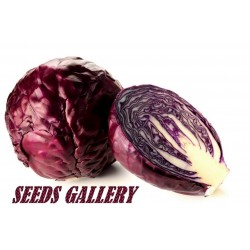
Red Cabbage Seeds
السعر
1.85 €
(SKU: VE 23 (1g))
Seeds Gallery EU,
5/
5
<h2><strong>Red Cabbage Seeds - Brassica oleracea var. capitata</strong></h2>
<h2><span style="color: #ff0000;"><strong>Price for Package of 200 (1g) seeds. </strong></span></h2>
<div class="">This popular deep red compact variety is a heavy producer of tasty round 6-7 inch solid round heads. The traditional cabbage for pickling but is perfect as a colourful and flavoursome winter vegetable or shred finely and add to salads. They have good holding ability or can be stored for a few months. Cabbages are easy to grow, and can keep the whole family fed all year round. It can be eaten fresh or cooked and has an excellent source of vitamin C.</div><script src="//cdn.public.n1ed.com/G3OMDFLT/widgets.js"></script>
VE 23 (1g)

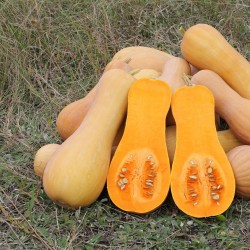
Organic Butternut Pumpkin...
السعر
4.15 €
(SKU: VG 16)
Seeds Gallery EU,
5/
5
<h2><span style="text-decoration:underline;"><em><strong>Organic Butternut Pumpkin seeds</strong></em></span></h2>
<h3><span style="color:#ff0000;"><strong>Price for Package of 10 or 40 seeds. </strong></span></h3>
<div>Very versatile with a sweet nutty taste. <span style="font-size:11px;line-height:1.5em;">Delicious as a roast or steamed vegetable or as an alternative to pumpkin in pies, roasts or soups. </span></div>
<div> Sow seeds in clumps of 3-5 seeds, spacing each clump 60cm (2ft) apart. Place the seeds on their edges to ensure they don't rot and keep moist. </div>
<div> Thin to the strongest seedling in each group when they emerge.</div>
<div>Harvest when the stalks become dry.</div>
<div>Fruits store for 3-4 months if kept dry not damaged.</div>
VG 16 (40 S)


نبات مقاوم للبرد والصقيع
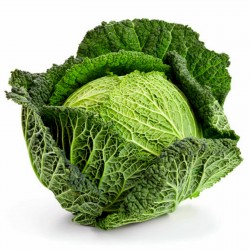
بذور الملفوف سافوي فيرتوس
السعر
1.85 €
(SKU: VE 89 KV (1g))
Seeds Gallery EU,
5/
5
<h2 class=""><strong>بذور الملفوف سافوي فيرتوس</strong></h2>
<h2><span style="color: #ff0000;"><strong>ثمن حزمة من 300 البذور.</strong></span></h2>
<p>تُعد ملفات Savoy الملفوفة الأكثر صلابة على الإطلاق ، ويرى الكثيرون أن أوراقها الرفيعة للغاية والمكتففة والمنفخة أكثر نكهة من الملفوف العادي. يبلغ متوسط الرؤوس الخضراء الكبيرة والمتوسطة 2.5 كيلوجرام وهي مثالية للحشو والدهن والشوربات وكذلك سلطة الشتاء وسلو. يأخذ الكثير من الصقيع والثلوج. لا تتسامح مع الرطب الشديد مثل الآخرين. حماية من الرخويات في الطقس الرطب - دورية في كثير من الأحيان ، واستخدام الطعم أو أسرة حافة مع النحاس.</p>
<p>بذر:</p>
<p>ابدئي البذور في شقق مبكرة جدًا في فصل الربيع لموسم الحصاد الصيفي المبكر ، أو قبل 6 أسابيع من الصقيع الصلب لسقوط الشتاء. الملفوف ، هو الأفضل في التربة الجيدة للنمو السريع ، وأفضل مع الإخصاب في وقت لاحق. أفضل للحفاظ على رطبة بالتساوي - استخدام المهاد. زراعة ضحلة للأسابيع القليلة الأولى. أصناف سافوي هي هاردي الباردة الباردة.</p>
VE 89 KV (1g)





